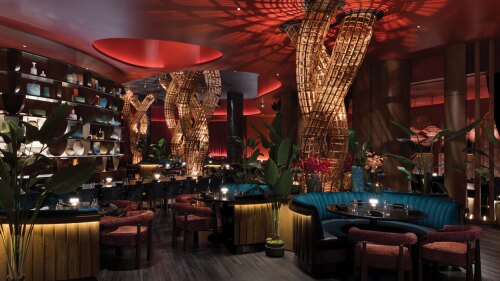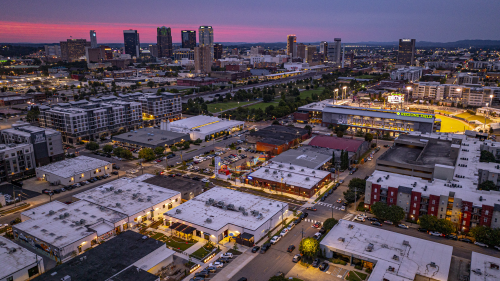Property Types
Hotels and Resorts
The hotel industry in the United States faces complex challenges in 2025, according to Jan Freitag, national director of hospitality analytics for the CoStar Group. During the “State of the U.S. Hotel Industry” presentation at the ULI 2025 Spring Meeting in Denver, Colorado, Freitag highlighted the challenges facing the hotel business amid macroeconomic uncertainty.
Once a sprawling expanse of uncharted land, Las Vegas, Nevada, has evolved into the entertainment capital of the world, a gaming super-hub, and a premier destination for sports. This remarkable transformation didn’t happen overnight; it stemmed from decades of strategic planning, investment, and visionary zoning recommendations.
Las Vegas is unlike any other place in America. Each year it draws more than 40 million visitors to the dazzling casinos and hotels that “turn night into daytime”—and transform the city into a glittering jewel in the desert. With 164,000 hotel rooms, Las Vegas is the largest hospitality market in the U.S.—outpacing Orlando, Florida, the next biggest market, by approximately 15 percent, according to JLL.
Industrial
Standing in the shadow of Regions Field and within earshot of Railroad Park, Birmingham’s Urban Supply hints at what the next chapter of downtown life could look like. Once-quiet brick warehouses are being steadily reimagined into patios, storefronts, and gathering spaces along a new pedestrian alley. Early tenants have begun to open their doors, and programming is slowly bringing people into the district. While the project is still in its early stages, the framework is in place for a vibrant hub that will grow block by block in the years ahead.
What trends are shaping the future of the industrial sector? Four experts from ULI’s Industrial and Office Park Development Council talk about the industrial submarkets and property types that offer the greatest opportunities, challenges developers face in bringing new projects to market, ways artificial intelligence and emerging technologies are reshaping the sector, tenant priorities, and other key trends.
After a quiet first half of 2024, CMBS originations increased 59 percent in Q3 on a year-over-year basis, according to the Mortgage Bankers Association’s Quarterly Survey.
Mixed-Use
Three-dimensional airspace subdivisions can add value to real estate developments.
Atlantic Wharf, a mixed-use development scheduled to include a waterfront plaza, 30,000 square feet (2,787 sq m) of retail and public spaces, and a 31-story, 750,000-square-foot (69,677-sq-m) Class A office tower, is taking shape in the capital of Massachusetts. And in strong markets around the New York metropolitan area, retail development appears to be a bright spot. In neighboring Connecticut, the single-family home sector is expected to strengthen this year, and the office market in northern New Jersey is starting to gain traction.
With U.S. cities increasingly strapped for cash, it comes as no surprise that community benefit districts (CBDs) are gaining in popularity. But will CBDs redefine America’s cities of the future? A growing number of property owners think so.
Multifamily
As congregations across North America grapple with shrinking membership and aging facilities, a new opportunity is emerging: transforming faith-owned land into affordable housing and community-serving spaces. At the 2025 ULI Fall Meeting in San Francisco, panelists in the session “Spiritual Brownfields: Declining Congregations and Opportunities for Housing on Faith-Owned Land” explored how churches and developers are partnering to bring mission-driven housing to underused sacred sites.
At the 2025 ULI Fall Meeting in San Francisco, leaders from across the development and construction industries discussed how they are adapting to a volatile yet stabilizing housing landscape in a session called “Report from the Field: Wrestling with the Cost of Housing Construction.” Despite headlines about tariffs, labor shortages, and inflation, the panelists agreed that the cost environment has settled into what one called a “new normal.”
A panel of insiders reveals what’s true—and false—about the housing crisis and how to fix it.
Office
On July 20—the same day the federal government announced its plans to close 40 percent of its data centers—panelists at a “Data Center Boom” event agreed that new data center development is booming. Read how the rapid shift to virtualization technology and cloud computing is spurring the government’s data center consolidation while also driving demand for new data centers and storage facilities.
Digital technology revolutionized the way entertainment professionals work, bringing about a convergence of media, entertainment, and technology that allows creative companies to downsize their workspace and locate wherever they please. Read about districts that are attracting entertainment firms with their interesting, edgy architecture and attractive lifestyle amenities and services.
In the age of creativity and innovation, developing “creative clusters” is vital to meeting the challenges of a new, global, knowledge-based economy. Read what visionaries in places like Chicago and Miami are doing to develop jobs-producing creative hubs targeting designers, graphic designers, and others representing one of fastest growth sectors of the new economy, the creative industries.
Residental
Can New York City really build or preserve 200,000 units of affordable housing over the next ten years?
New York City Mayor Bill de Blasio has proposed what some have called the most ambitious housing plan put forth by any U.S. mayor.
As walkable urban places have become more commonplace across the national real estate landscape, the subject of affordability within these communities has become a greater concern.
Retail
For decades, civic leaders have tried to revitalize Market Street, San Francisco’s central thoroughfare, only to see their efforts founder. “I sometimes call it the great white whale of San Francisco,” says Eric Tao, managing partner at L37 Development in San Francisco and co-chair of ULI San Francisco. “Every new mayor, every new planning director, every new economic development director has chased that white whale.” This year, however, an international competition of ideas hosted and run by ULI San Francisco, with support from the ULI Foundation, generated fresh momentum for reimagining the boulevard. The competition drew 173 submissions from nine countries and sparked new conversations about the future of downtown San Francisco.
The OAK project began in 2009, when a development firm set their sights on the corner of Northwest Expressway and North Pennsylvania Avenue, the state’s most important and busiest retail intersection. As the region’s only parcel capable of supporting a vertically integrated project of this scale and density, that land represented an opportunity to create something truly special.
As aging retail continue to evolve, one increasingly popular trend has been to redesign malls as town centers—recalling a time when such commercial districts were the heart and soul of a community. Mall–to–town center retrofits are emerging throughout the nation, especially in suburban communities, where pedestrian-friendly, mixed-use environments are highly attractive to millennials now raising families.















